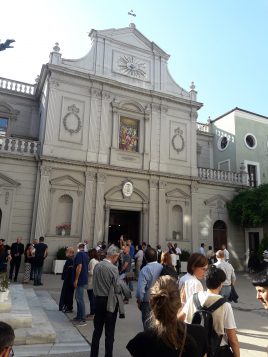
(from Istanbul) – The home of Muhammad and his Iraqi co-nationals is located at the end of a very steep stairway. The apartment in the Kurtuluş district of Istanbul, where most low-income Kurds and Turks live, is below street level. It’s poor and dignified. The only pieces of furniture are a painting depicting the Holy Virgin, an old-fashioned television set and little else. It is inhabited by three young Christians; they were forced to flee from Baghdad six years ago because of what was viewed as their excessively western lifestyle. Muhammad, who is now 26-years-old and dreamed of becoming an artist in Iraq, received serious threats from Isis for having uploaded a video in which he dances with girls and boys, and was forced to flee. He speaks fluent English. He was granted political refugee status three years ago. He found a low-paid job in a low-cost hair transplant clinic, where men flock in from all over the Middle East. But Muhammad feels he has no future prospects. “I wished to continue university studies but the fees here are very high”, he said. “I applied five times to go to Australia, or to Canada with my brother, but my request was always rejected. I lost everything, my family is in Iraq. We are forced to remain in Turkey. Had I known what was in store for me, I would not have left. Luckily, I was helped by the Salesians: they were the only ones who opened their doors to us.”
- foto SIR
 The difficult life of Christians in Turkey. Muhammad and his friends are among some 6,000 Christians who live in Turkey and are members of Christian communities, usually well hidden from view. Even Istanbul’s cathedral is undetectable from the main street, the facade is nestled in an inner courtyard. The church is filled with faithful of many different nationalities even on weekday Masses. According to official figures, Christians of all denominations in Turkey make up less than 1% of the population (70 million inhabitants). In a megalopolis like Istanbul, with 20 million inhabitants and 560,000 Syrian refugees, Catholic churches are mainly attended by refugees and migrants. They arrived from Syria, Pakistan, Afghanistan, Palestine, Sub-Saharan African countries. And life is not easy. “Turkish is the language spoken in Turkey, but Middle Eastern Christians speaking Arabic. It is unrealistic to think that a Syrian, especially if Christian, can feel at home here”, said Msgr. Paul Russel, Apostolic Nuncio to Turkey, who co-organized in Istanbul, with Caritas Italy, the annual Migramed meeting that brings together representatives of diocesan Caritas and Caritas centres in the Mediterranean region. This year’s meeting focused on migrants’ eastern route to Europe through Turkey, Greece and the Balkans, in continuous growth. For example, in Turkish schools, “Christian students are under great pressure from their teachers – the nuncio pointed out – which is why many of them renounce education all together.” The nunciature is working hard to replicate and expand the experience of the humanitarian corridors together with Caritas Italy. Last year 4 Syrian Christian families were given hospitality by the dioceses of Bari, Altamura, Bergamo and Como.
The difficult life of Christians in Turkey. Muhammad and his friends are among some 6,000 Christians who live in Turkey and are members of Christian communities, usually well hidden from view. Even Istanbul’s cathedral is undetectable from the main street, the facade is nestled in an inner courtyard. The church is filled with faithful of many different nationalities even on weekday Masses. According to official figures, Christians of all denominations in Turkey make up less than 1% of the population (70 million inhabitants). In a megalopolis like Istanbul, with 20 million inhabitants and 560,000 Syrian refugees, Catholic churches are mainly attended by refugees and migrants. They arrived from Syria, Pakistan, Afghanistan, Palestine, Sub-Saharan African countries. And life is not easy. “Turkish is the language spoken in Turkey, but Middle Eastern Christians speaking Arabic. It is unrealistic to think that a Syrian, especially if Christian, can feel at home here”, said Msgr. Paul Russel, Apostolic Nuncio to Turkey, who co-organized in Istanbul, with Caritas Italy, the annual Migramed meeting that brings together representatives of diocesan Caritas and Caritas centres in the Mediterranean region. This year’s meeting focused on migrants’ eastern route to Europe through Turkey, Greece and the Balkans, in continuous growth. For example, in Turkish schools, “Christian students are under great pressure from their teachers – the nuncio pointed out – which is why many of them renounce education all together.” The nunciature is working hard to replicate and expand the experience of the humanitarian corridors together with Caritas Italy. Last year 4 Syrian Christian families were given hospitality by the dioceses of Bari, Altamura, Bergamo and Como.
Schools, places of worship, cultural centres, are difficult to build. “If there is no possibility of opening a school, a place of worship, a cultural centre, then it becomes much harder for Christians to live in a society where they are but a small minority”, said MonsignorPaolo Bizzeti, Apostolic Vicar of Anatolia and President of Caritas Turkey. The seat of Anatolia’s vicariate is located in Iskendur. “Christian refugees are experiencing a double tragedy”, he pointed out. “They were forced to abandon their land and their loved ones as a result of the war or because of persecutions, and they also discovered that Christian Europe, which defends human rights, shuts them out. They feel that their identity is not being recognised and accepted. Who will heal their wounds?”
Four million refugees and migrants in Turkey. Turkey took in 4 million refugees and migrants, including 3,370,000 Syrians, in the past few years. It’s the country that hosts the largest number of refugees worldwide. The 2016 agreement between the EU and Turkey, which is currently under discussion, proved unsuccessful. The main obstacle is Greek’s cumbersome bureaucracy: only 12,489 Syrian refugees have been resettled in Europe (4,313 in Germany, 3,608 in the Netherlands, 1,401 in France and 1,200 in France). 1,446 Syrians were resettled in Turkey in 2016-2018. Turkey reportedly received only half of a 6 billion-Euro package promised by the EU (EU institutions require credible projects), while the Turkish authorities claim to have spent 40 billion dollars on migrant refugees in 8 years.
The humanitarian tragedy in Greek islands. The Turkish coasts are only 6 miles away from the Greek Aegean islands. Arrivals in this area increased by 55% compared to last year: in 2019 36,582 people disembarked from 1124 inflatable dinghies. The situation on the islands of Lesbos and Samos has become unsustainable, “inhumane” according to humanitarian workers. Last Sunday in the Moria camp in Lesbos, a woman and a child died as a result of a blaze. There are 7,000 people living there, including 4,000 children surrounded by barbed wire, with very high levels of malnutrition, risk of depression and suicide. Makeshift encampments outside are dirty, with spoiled food and very few services. The few volunteers on the island are facing a daunting challenge. “The Greek islands are beautiful for tourists but not for refugees,” said Maria Alverti, director of Caritas Greece.
- Istanbul
The Balkan Route is the other main migratory path. Between 7,000 and 10,000 people are massed in abandoned landfills and factories in Bihac, on the north-western border of Bosnia-Herzegovina. All of them young migrants trying to illegally cross the border into Croatia. “There is a full-scale humanitarian emergency just a few kilometres from the Italian border”, reported Daniele Bombardi, Caritas Italy worker in Bosnia. The Balkan route is increasingly being used as an alternative to the Central Mediterranean route. The numbers are increasing: in the last 8 months 30,000 people have entered Bosnia-Herzegovina. Following the peak of 1 million refugees knocking on Europe’s doors in 2015, this route was never closed and it risks escalating into an explosive problem again.” This crisis transcends the emergency – concluded Oliviero Forti, in charge of immigration for Caritas Italy -. We must tackle this phenomenon in terms of stability, handing over responsibilities to our colleagues at Caritas, as well as the resources.”
























